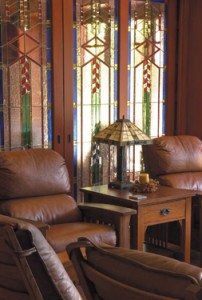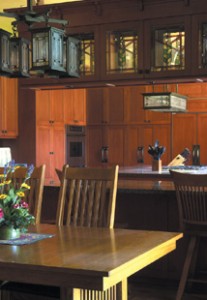by Ken and Laura Liang
 In 2002, we decided it was time to build a house for ourselves and our three young daughters — a place the kids could grow up in and have special fond memories of, a place where we could be comfortable together yet have our own more private domains when we needed them for study, work and sleep.We had no preconceptions of what style of house we wanted; we were focused on the functionality of our family life and on developing spaces that afforded the kind of casual day-to-day living we enjoy.
In 2002, we decided it was time to build a house for ourselves and our three young daughters — a place the kids could grow up in and have special fond memories of, a place where we could be comfortable together yet have our own more private domains when we needed them for study, work and sleep.We had no preconceptions of what style of house we wanted; we were focused on the functionality of our family life and on developing spaces that afforded the kind of casual day-to-day living we enjoy.
We had adapted to other houses we had lived in, but we were always aware that we were adapting our lives to someone else’s notions of how architectural styles and spaces support family life — or even someone else’s idea of what family life is all about. The older houses we lived in had character but lacked the functionality and modern amenities we wanted. Newer houses built to the maximum allowed space lacked character and looked out of place in more established neighborhoods. It was time to figure it out for ourselves.
We also wanted to see for ourselves if the experience of building a house is as bad as all the “war stories” we had heard suggested it is. It wasn’t. We’re proud to say we survived our first home-building experience. We actually enjoyed it, primarily because we worked with great people throughout our process and stuck to our original plans.
We wanted to build a house that was, first and foremost, a functional space designed to suit our family’s needs in the 21st century. Beyond that, we wanted to build a home that fit in well with the neighborhood and environment surrounding it; we did not want to impose an outsized new home into a neighborhood with 40- to 70-year-old homes.
And while we wanted a spacious house that would be large in terms of square footage, we wanted it to present a handsome but not intrusive profile to the street and convey a warm and lived-in feeling. Finally, we were determined to build within a defined budget in terms of both dollars and time.
Because we wanted a large house with lots of outdoor space, the first object was to find the site. Our search led us to a quiet neighborhood in La Canada Flintridge, in the foothills northwest of the Rose Bowl in Pasadena, where we found an older ranch house on a 34,000-square-foot flat lot overlooking a shallow canyon, with a view of the San Gabriel Mountains to the east and north. One feature of the site that especially attracted us is that it has a modest frontage but fans out to the rear on both sides to provide plenty of space for outdoor amenities and activities.
For the design of the house itself, we turned to Dave De Angelis, a designer who had extensive experience in constructionand then spent six years as a draftsman for a well-known local architect before beginning his own architectural practice. We chose to work with Dave for three main reasons. First, he was passionate about his craft. Second, he was willing to work — on a collaborative basis — with first-time homeowner-builders like us who had clear ideas and strong preferences but who also wanted to thoroughly explore alternatives and learn about design and building. Third, because of his construction experience, he knew what would actually work when it came to putting the two-by-fours together; we were confident there would be few — if any — surprises when we went from designing to building.
It also helped that Dave does all of his design work on the computer, which meant that he could, and did, produce design revisions literally overnight during the six months we spent in the design phase. Dave also understood we had a budget and held to it, sometimes better than we did.
Early on, we decided on a two-story arrangement, with the “public” spaces on the ground floor and private and utility spaces upstairs. Our floor plan began with what we regard as the core of our living space: a large kitchen that flows into an even larger family room, where knew we would spend most of our time together as a family.
 We also wanted that combined space to flow naturally to the outside, so we had the family room open out to a large covered patio. We made the living and dining rooms relatively small by most standards; we knew that we would probably spend no more than about two weeks out of a year in those rooms. We wanted them to fit comfortably into our house, but we didn’t want to put a lot of emphasis on them.
We also wanted that combined space to flow naturally to the outside, so we had the family room open out to a large covered patio. We made the living and dining rooms relatively small by most standards; we knew that we would probably spend no more than about two weeks out of a year in those rooms. We wanted them to fit comfortably into our house, but we didn’t want to put a lot of emphasis on them.
We put Ken’s study next to the living room, with stained-glass pocket doors separating the two rooms. An investment manager and attorney, he spends a fair amount of time working on weekends, and his working space is far enough down the hall from the kitchen and family room to be relatively quiet, yet close enough to be easily accessible. A guest bedroom and bath are across the hall from the study.
We put the family bedrooms — each with its own bath — and the enclosed laundry area all upstairs. Because we did it all by computer, working through the hundreds of design iterations was fast and nearly effortless — even though it did take six months. By the time we were two-thirds through the design process, we had detailed plans and elevations for every interior space and surface in the house. Only then did we turn to the exterior design and the question of architectural style.
Style: Coming to Craftsman
 Ken’s comfort with the warm atmosphere conveyed by interior wood — something, perhaps, that goes with being an attorney and spending much of his life surrounded by books and bookshelves in law libraries — led us to decide that the interior surfaces of the house would be dominated by stained wood. And it was that decision, combined with our search for an exterior style that would fit naturally into our neighborhood, that drew us to the Craftsman style.
Ken’s comfort with the warm atmosphere conveyed by interior wood — something, perhaps, that goes with being an attorney and spending much of his life surrounded by books and bookshelves in law libraries — led us to decide that the interior surfaces of the house would be dominated by stained wood. And it was that decision, combined with our search for an exterior style that would fit naturally into our neighborhood, that drew us to the Craftsman style.
Although the interior design had been completed from a purely functional standpoint before we even looked at possible exteriors, it became clear that the functional forms we had designed reflected Craftsman principles and that a Craftsman style fit our needs and tastes ideally. We discovered American Bungalow one day when we visited Historic Lighting in Monrovia to see if we could get ideas and craftsman referrals.
We bought all the back issues we could find and used them for guidance on the Craftsman theme and on specific features of the interior and exterior, like the height of the wainscoting, the depth of the fireplace mantel, tiling for bathrooms and fireplaces, color schemes and the detailing of the stairway banisters. And, of course, we bought and studied all of the popular Craftsman and bungalow books.
For the exterior, we decided to use a combination of darkly painted synthetic shingles and stone. Synthetic shingles aren’t “pure” Craftsman style, of course, but we weren’t looking for purity. We were looking for functionality — in this case, durability, ease of maintenance and, above all, safety: synthetic shingles are fireproof. To enhance the visual texture of the shingled surfaces, we experimented with staggering the elevation of the shingles in each row. The result is a rustic appearance that seems to work.
 When we reached the end of the design process, we had a fifty-page plan that specified every detail of the house, inside and out. As a result, the construction process was amazingly orderly and straightforward, and everyone who worked on the project was able focus on the quality of what they were doing. We like to think that, in a way, the great amount of time and attention we spent on planning and design contributed to the quality of our finished product in a way that’s similar to the quality that resulted from the years of experience and practice that traditional Arts and Crafts designers and builders brought to their work. That, at any rate, is our hope.
When we reached the end of the design process, we had a fifty-page plan that specified every detail of the house, inside and out. As a result, the construction process was amazingly orderly and straightforward, and everyone who worked on the project was able focus on the quality of what they were doing. We like to think that, in a way, the great amount of time and attention we spent on planning and design contributed to the quality of our finished product in a way that’s similar to the quality that resulted from the years of experience and practice that traditional Arts and Crafts designers and builders brought to their work. That, at any rate, is our hope.
Since we completed the house, we’ve had many compliments on how well we “renovated” this “old Craftsman house.” We couldn’t be more pleased. We understand, of course, that our house is a 21st-century interpretation of the Craftsman style, but we’ve embraced it because it is a “basic” design executed — we think — to perfection.
Pin It


